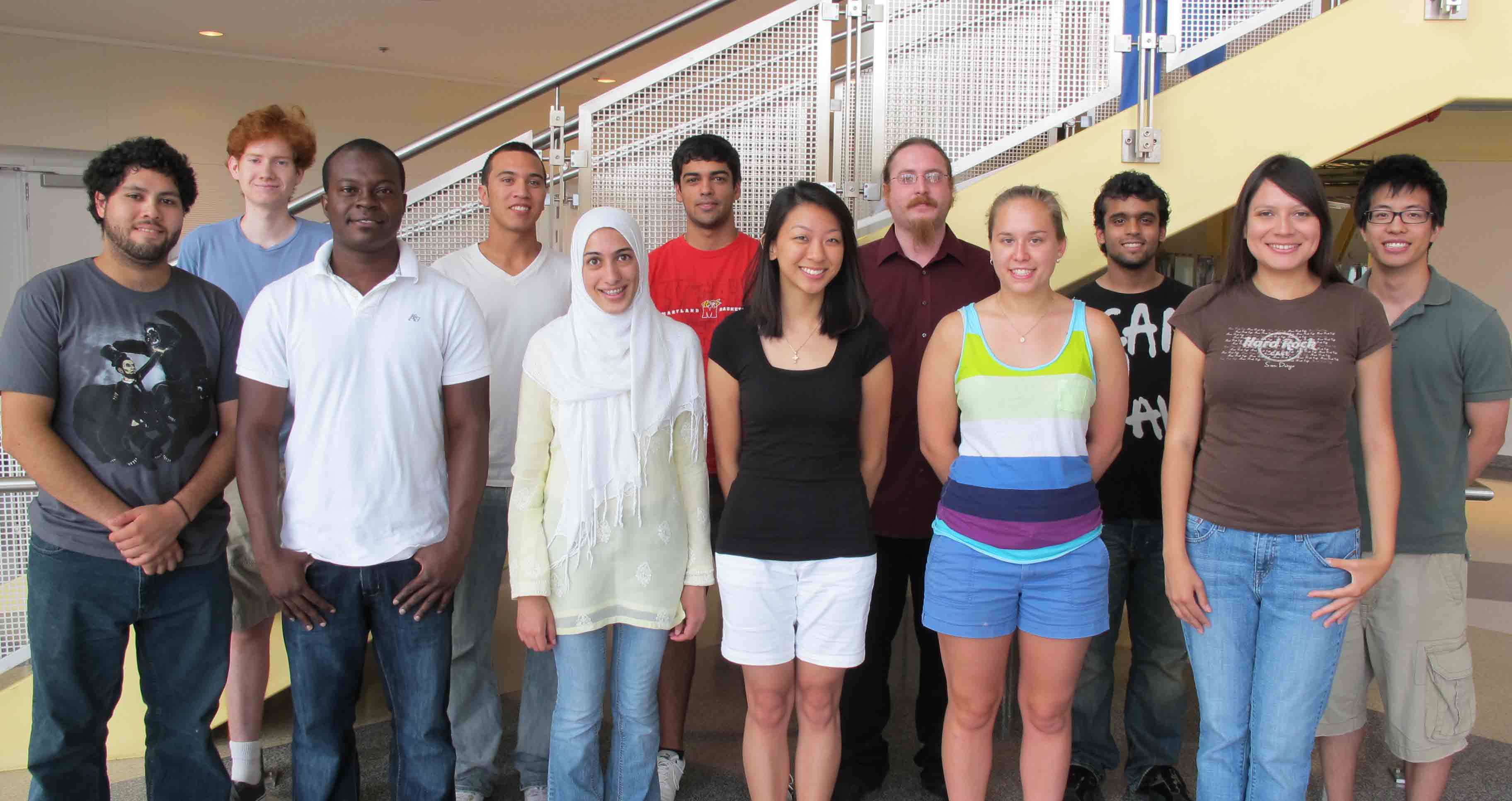| |
|
|
|
|
| |
|
|
|
|
| |
|
|
|
|
| |
|
MERIT
Fair 2010
|
|
|
| |
|
Overview, Project Abstracts, Presentation Slides & Posters, & Research Papers |
|
|
| |
|
Friday, August 6, 2010 |
|
|
| |
|
|
|
|
| |
|
|
|
|
| |
|
Some of the MERIT Fair 2010 Participants
(click on photos to enlarge)
|
|
|
| |
|
The MERIT Fair is held
at the end of the summer to showcase the research conducted by the
undergraduate students during the summer. This forum provides the BIEN students
with the opportunity to present their work to the wider public.
Their efforts are subjected to scrutiny from a panel of judges selected
from academia, industry, and government laboratories. Prizes were awarded for best
overall project, runner-up for best project, and best written report. |
|
|
| |
|
|
|
|
| |
|
MERIT
Fair 2010 Prize-Winning Projects |
|
|
| |
|
|
|
|
| |
|
|
|
|
| |
|
Biosystems Internships for Engineers (BIEN) |
|
|
| |
|
|
|
|
| |
|
|
|
|
| |
|
BIEN Project Abstracts, Technical Reports, and Presentation Slides |
|
|
| |
|
|
|
|
|
|
Neural Imaging of Visual Word Processing in Aphasia Patients
Abdulaziz Al-Turki (University of Maryland at College Park)
Corinne Cameron (University of Alaska in Anchorage)
Mentors:
Prof. Jonathan Simon (UMCP) and
Nai Ding (UMCP).
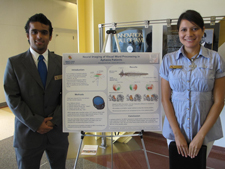 We use signal processing and statistical methods to investigate how the human brain electrically processes visual information. Using magnetoencephalography (MEG) measurements from normal subjects and aphasic patients, we compare how different current methods influence our results. These methods are then used to observe and measure how the brain reacts to visually presented words and to localize a neural source for this activity. Finally, using pre- and post-therapy MEG data from aphasic patients, we investigate whether this therapy changes the neural processing of visual words and how it is different than that in a normal brain. We use signal processing and statistical methods to investigate how the human brain electrically processes visual information. Using magnetoencephalography (MEG) measurements from normal subjects and aphasic patients, we compare how different current methods influence our results. These methods are then used to observe and measure how the brain reacts to visually presented words and to localize a neural source for this activity. Finally, using pre- and post-therapy MEG data from aphasic patients, we investigate whether this therapy changes the neural processing of visual words and how it is different than that in a normal brain.
Presentation Slides
Project Poster
Technical Report
|
|
|
|
|
Measurement of Energy Absorption from Antennas Placed near Models of the Human Body
Samah Beg (George Washington University)
Miguel Gonzalez (University of Pennsylvania)
Mentors: Prof. Christopher Davis (UMCP), John Rzasa (UMCP), and Navik Agrawal (UMCP)
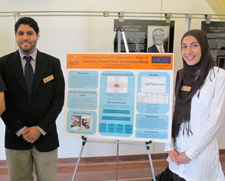 The FCC has set exposure limits on the amount of radiation that can be emitted from wireless devices and absorbed by the human body. This is determined by measuring the amount of energy absorbed by the body, or the Specific Absorption Rate (SAR). Current methods for measuring the SAR from cell phones placed near the human body are somewhat inaccurate and slow, the equipment involved is large and expensive, and there is room for improvement. The testing method we are studying incorporates a base station emulator that calls a phone whose radiation is absorbed by a model of the human body consisting of a saline solution inside a glass structure. By projecting a set of lasers through the structure and measuring their deflection due to a change in index of refraction, one can measure the rate of temperature rise of the model which determines the amount of energy absorbed. To make this method reliable the lasers used must point accurately through the absorbing medium at lateral effect photodiodes. The principle goal of our project is to study and improve the stability of this laser pointing. The FCC has set exposure limits on the amount of radiation that can be emitted from wireless devices and absorbed by the human body. This is determined by measuring the amount of energy absorbed by the body, or the Specific Absorption Rate (SAR). Current methods for measuring the SAR from cell phones placed near the human body are somewhat inaccurate and slow, the equipment involved is large and expensive, and there is room for improvement. The testing method we are studying incorporates a base station emulator that calls a phone whose radiation is absorbed by a model of the human body consisting of a saline solution inside a glass structure. By projecting a set of lasers through the structure and measuring their deflection due to a change in index of refraction, one can measure the rate of temperature rise of the model which determines the amount of energy absorbed. To make this method reliable the lasers used must point accurately through the absorbing medium at lateral effect photodiodes. The principle goal of our project is to study and improve the stability of this laser pointing.
Presentation Slides
Project Poster
Technical Report
|
|
|
|
|
Optimizing Bacterial Adhesion to a Microfluidic Platform for Monitoring Bacterial Biofilm Growth
Aaron Cheng (George Washington University)
Mentors:
Prof. Reza Ghodssi (UMCP), Peter Dykstra (UMCP), and
Mariana Meyer (UMCP)
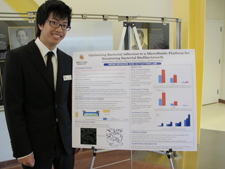 Formation of bacterial biofilms, composed primarily of bacterial cells and a matrix of extracellular polysaccharides that provide the microorganisms advantages such as increased antibiotic resistance, involves an initial attachment of bacteria to a surface. A device has been designed to optically monitor the growth of biofilms under microfluidic conditions. Incorporation of poly-L-lysine and fibrinogen bound to the walls of the device was utilized to increase preliminary adhesion of Escherichia coli BL21 to the coated surfaces by approximately 100% and 200%, respectively. Bacterial incubation duration was optimized at 2 hours. Results are expected to enhance repeatability of biofilms formed in microfluidics. Formation of bacterial biofilms, composed primarily of bacterial cells and a matrix of extracellular polysaccharides that provide the microorganisms advantages such as increased antibiotic resistance, involves an initial attachment of bacteria to a surface. A device has been designed to optically monitor the growth of biofilms under microfluidic conditions. Incorporation of poly-L-lysine and fibrinogen bound to the walls of the device was utilized to increase preliminary adhesion of Escherichia coli BL21 to the coated surfaces by approximately 100% and 200%, respectively. Bacterial incubation duration was optimized at 2 hours. Results are expected to enhance repeatability of biofilms formed in microfluidics.
Presentation Slides
Project Poster
Technical Report
|
|
|
|
|
Pattern Memory and Analysis in Bat-Inspired Echolocation Systems
Patrick Ellis (Bradley University)
Mentors:
Prof. Timothy Horiuchi (UMCP) and
Tarek Massoud (UMCP)
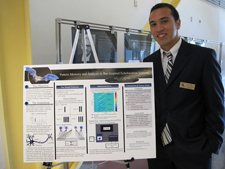 Bats are well known to have the ability to navigate the world in a manner completely foreign to human beings – echolocation. Delving into echolocation has prolific opportunities to influence the technologies of today and the future. We are using a sonar-based system modeled on the bats’ echolocating abilities to support the ongoing development of a neuromorphic VLSI head-direction cell model. The system consists of a neural network that uses the reflected sonar signals to learn and identify different objects present in an environment. The information provided by this system will be used to help orient the head direction cell system and provide a calibration signal to prevent it from drifting. Bats are well known to have the ability to navigate the world in a manner completely foreign to human beings – echolocation. Delving into echolocation has prolific opportunities to influence the technologies of today and the future. We are using a sonar-based system modeled on the bats’ echolocating abilities to support the ongoing development of a neuromorphic VLSI head-direction cell model. The system consists of a neural network that uses the reflected sonar signals to learn and identify different objects present in an environment. The information provided by this system will be used to help orient the head direction cell system and provide a calibration signal to prevent it from drifting.
Presentation Slides
Project Poster
Technical Report
|
|
|
|
|
Comparison of Histone Protein Locating Algorithms
Kate Fischl (Princeton University)
Mentors:
Prof. Min Wu (UMCP),
Prof. Jiuzhou Song (UMCP),
Avinash Varna (UMCP),
Wei-Hong Chuang (UMCP), and
Apratim Mitra (UMCP),
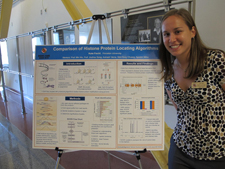 Epigenetics encompasses the study of changes in gene expression caused by factors outside of the DNA sequence, and helps to strengthen understanding of disease and cell malfunctions. One such epigenetic endeavor involves using chromatin immunoprecipitation (ChIP) along with large-scale DNA sequencing (ChIP-Seq) to locate specific histone protein modifications whose existence is linked to gene expression. This project focuses on understanding the distinct ChIP-Seq software packages, all of which use a different form of peak detection to locate histone modifications. Because the algorithms vary, this project marks the first step towards developing an ideal algorithm for use in a collaborative cross-disciplinary effort here at the University of Maryland. Epigenetics encompasses the study of changes in gene expression caused by factors outside of the DNA sequence, and helps to strengthen understanding of disease and cell malfunctions. One such epigenetic endeavor involves using chromatin immunoprecipitation (ChIP) along with large-scale DNA sequencing (ChIP-Seq) to locate specific histone protein modifications whose existence is linked to gene expression. This project focuses on understanding the distinct ChIP-Seq software packages, all of which use a different form of peak detection to locate histone modifications. Because the algorithms vary, this project marks the first step towards developing an ideal algorithm for use in a collaborative cross-disciplinary effort here at the University of Maryland.
Presentation Slides
Project Poster
Technical Report
|
|
|
|
|
A Vision-based System for the Tracking of Mobile Mini-robots
Andy Hammond (University of Maryland at College Park)
Ken Tossell (University of Maryland at College Park)
Mentors:
Prof. Nuno Martins (UMCP) and
Eduardo Arvelo (UMCP)
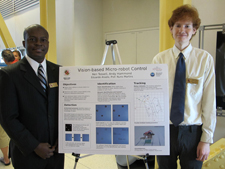 In an effort to make use of a swarm of ant-sized robots that lack optical sensing and advanced computation capabilities, we have developed a hybrid algorithm that implements image processing at high frame rates to develop fast and slow background adaptation techniques for real time external visual tracking of micro-robots using a single camera. The algorithm identifies each micro-robot, determines their position and orientation and computes their velocities. Ultimately, this information will be utilized in the control and coordination of these ant-sized robots by either transmitting it to individual micro-robots on request, or by using these parameters as inputs in control algorithms developed for the autonomous ant-sized robots currently under development at UMD. In an effort to make use of a swarm of ant-sized robots that lack optical sensing and advanced computation capabilities, we have developed a hybrid algorithm that implements image processing at high frame rates to develop fast and slow background adaptation techniques for real time external visual tracking of micro-robots using a single camera. The algorithm identifies each micro-robot, determines their position and orientation and computes their velocities. Ultimately, this information will be utilized in the control and coordination of these ant-sized robots by either transmitting it to individual micro-robots on request, or by using these parameters as inputs in control algorithms developed for the autonomous ant-sized robots currently under development at UMD.
Presentation Slides
Project Poster
Technical Report
|
|
|
|
|
Micro-Robot Control and Coordination
Lydia Lei (University of Maryland at College Park)
Christopher Perkins (University of Maryland at College Park)
Mentors:
Prof. Pamela Abshire (UMCP),
Andy Turner (UMCP),
Timir Datta (UMCP), and David Sander (UMCP)
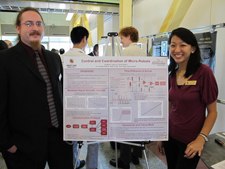 Due to space limitations, micro-robots must operate with restricted processing and sensing capabilities. Consequently, obtaining intelligent and coordinated behavior from a swarm of micro-robots is a challenge. Our goal is to develop a swarm of micro-robots that rely only on their on-board processing and communication capabilities.
Prior researchers have developed algorithms for movement/control and explored distance sensing using Received Signal Strength Indication (RSSI). We plan to begin the implementation of this research in mini-robots, as well as develop inter-robot communication protocols and an alternative technique for distance sensing (thunder and lightning) with the ultimate goal of achieving coordinated swarm activity. Due to space limitations, micro-robots must operate with restricted processing and sensing capabilities. Consequently, obtaining intelligent and coordinated behavior from a swarm of micro-robots is a challenge. Our goal is to develop a swarm of micro-robots that rely only on their on-board processing and communication capabilities.
Prior researchers have developed algorithms for movement/control and explored distance sensing using Received Signal Strength Indication (RSSI). We plan to begin the implementation of this research in mini-robots, as well as develop inter-robot communication protocols and an alternative technique for distance sensing (thunder and lightning) with the ultimate goal of achieving coordinated swarm activity.
Presentation Slides
Project Poster
Technical Report
|
|
|
|
|
Algorithms on Noisy Speech for Hearing-Aid Users
Nicholas Prior (University of Maryland at College Park)
Mentors:
Prof. Carol Espy-Wilson (UMCP) and
Srikanth Vishnubhotla (UMCP)
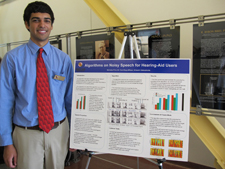 The existing speech extraction algorithm developed by the Speech Communication Lab will be analyzed to see how well it functions for hearing aid users. This analysis will look at two components of speech extraction: speech enhancement (removal of noise), and speech segregation (separation of multiple speech signals). The processed speech signal will be compared to the original clean speech signal to analyze the preservation of the spectral and temporal properties, and the correlation between the original and processed speech signals will be quantitatively described. Listener tests will also be conducted to subjectively see how well the speech extraction algorithm performs for hearing aid users. The results of these two analyses will be put together to see where the tests failed with respect to the properties of the ear. Based on these results, potential improvements and recommendations may be made to the original speech extraction algorithm. The existing speech extraction algorithm developed by the Speech Communication Lab will be analyzed to see how well it functions for hearing aid users. This analysis will look at two components of speech extraction: speech enhancement (removal of noise), and speech segregation (separation of multiple speech signals). The processed speech signal will be compared to the original clean speech signal to analyze the preservation of the spectral and temporal properties, and the correlation between the original and processed speech signals will be quantitatively described. Listener tests will also be conducted to subjectively see how well the speech extraction algorithm performs for hearing aid users. The results of these two analyses will be put together to see where the tests failed with respect to the properties of the ear. Based on these results, potential improvements and recommendations may be made to the original speech extraction algorithm.
Presentation Slides
Project Poster
Technical Report
|
|
|
| |
|
|
|
|

